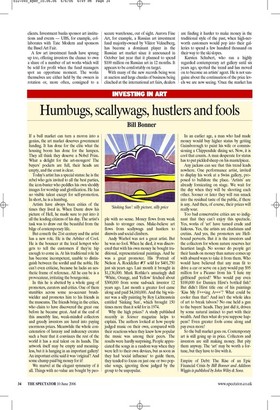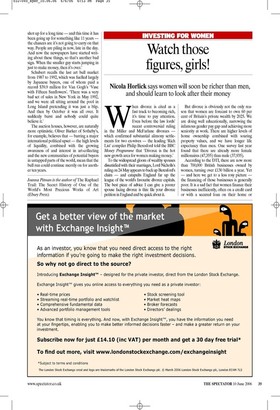INVESTING IN ART
Humbugs, scallywags, hustlers and fools
Bill Bonner
If a bull market can turn a moron into a genius, the art market deserves government funding. It has done for the elite what the housing boom has done for the lumpen. They all think they deserve a Nobel Prize. What a delight for the art-mongers! The buyers’ pockets are full, their heads are empty, and the coast is clear.
Today’s artist has a special status: he is the rebel who gets invited to all the best parties, the icon-buster who peddles his own shoddy images for worship and glorification. He has no visible talent except for self-promotion. In short, he is a humbug.
Artists have always been critics of the times they lived in. When Dante drew his picture of Hell, he made sure to put into it all the leading citizens of his day. The artist’s task was to draw out the beautiful from the bilge of contemporary life.
But cometh the 21st century and the artist has a new role. He is the Arbiter of Cool. He is the bouncer at the local hotspot who gets to tell the customers if they’re hip enough to come in. At his traditional role he has become incompetent, unable to distinguish between the sordid and the noble. He can’t even criticise, because he lacks an aesthetic frame of reference. All he can be is a provocateur, irritating the bourgeoisie.
In this he is abetted by a whole gang of promoters, curators and critics. One of them stumbles across some no-account brushwielder and promotes him to his friends in the museums. The friends bring in the critics, who claim to have discovered the great one before he became great. And at the end of this assembly line, weak-minded collectors and greedy investors are lured into paying enormous prices. Meanwhile the whole concatenation of larceny and indecency creates such a buzz that it convinces the rest of the world it has a real talent on its hands. The artwork itself may be empty and meaningless, but it is hanging in an important gallery! An important critic said it was ‘original’! And some chump paid big money for it!
We marvel at the elegant symmetry of it all. Things with no value are bought by peo ple with no sense. Money flows from weak hands to stronger ones. Make-believe art flows from scallywags and hustlers to dimwits and social climbers.
Andy Warhol was not a great artist. But he was no fool. When he died, it was discovered that with his own money he bought traditional, representational paintings. And he was a great promoter. His ‘Portrait of Nelson A. Rockfeller #3’ sold for $401,750 just six years ago. Last month it brought in $1,136,000. Mark Rothko’s amazingly dull ‘White, Orange, and Yellow’ fetched about $300,000 from some sad-sack investor 12 years ago. Last month a greater fool came along and paid $4,160,000. And the big winner was a silly painting by Roy Lichtenstein entitled ‘Sinking Sun’, which brought 150 times more than it sold for in 1974.
Why the high prices? A study published recently in Science magazine helps to explain. The authors looked at how people judged music on their own, compared with their reactions when they knew how popular the music was among their peers. The results were hardly surprising. People appreciated the songs in a random way when they were left to their own devices, but as soon as they had ‘social influence’ to guide them, they tended to focus on just one or two popular songs, ignoring those judged by the group to be unpopular. In an earlier age, a man who had made money would buy higher status by getting Gainsborough to paint his wife or commissioning a Chippendale dining set. Now, it is cool that counts. A man desperate for status has to put pickled sheep on his mantelpiece.
Any jackass can see that this trend leads nowhere. One performance artist, invited to display his work at a Swiss gallery, proposed to bulldoze the place. ‘Artists’ are already fornicating on stage. We wait for the day when they will be shooting each other. Sooner or later they will run smack into the residual taste of the public, if there is any. And then, of course, their prices will really soar.
Too bad conservative critics are so indignant that they can’t enjoy this spectacle. Yes, works of ‘art’ have turned crude and hideous. Yes, the artists are charlatans and cretins. And yes, the promoters are Hellbound perverts. But it is the investors and the collectors for whom nature reserves her heartiest laugh. No sooner do people get their hands on money than nature comes up with absurd ways to take it from them. Who would have believed that any man fit to drive a car or serve on a jury would pay $95 million for a Picasso from his ‘I hate my girlfriend’ period? Who would pay even $100,000 for Damien Hirst’s bottled fish? But didn’t Hirst title one of his paintings ‘Kiss My F***ing A***’? What could be cooler than that? And isn’t the whole idea of art to break taboos? No one held a gun to the buyers’ heads. They just did it, driven by some natural instinct to part with their wealth. And then what do you suppose happens? Even greater fools come along and pay even more!
So the bull market goes on. Contemporary art is still going up in price. Collectors and investors are still making money. But pity them anyway. The ‘art’ may be worth a fortune, but they have to live with it.
Empire of Debt: The Rise of an Epic Financial Crisis by Bill Bonner and Addison Wiggin is published by John Wiley & Sons. shot up for a long time — and this time it has been going up for something like 11 years the chances are it’s not going to carry on that way. People are piling in now, late in the day. And now the newspapers have started writing about these things, so that’s another bad sign. When the smaller guy starts jumping in just to make money, then it’s over.’ Schubert recalls the last art bull market from 1987 to 1992, which was fuelled largely by Japanese buyers, one of whom paid a record $39.9 million for Van Gogh’s ‘Vase with Fifteen Sunflowers’. ‘There was a very bad set of sales in New York in May 1992, and we were all sitting around the pool in Long Island pretending it was just a blip. And then by October it was all over. It suddenly burst and nobody could quite believe it.’ The auction houses, however, are naturally more optimistic. Oliver Barker of Sotheby’s, for example, believes that — barring a major international political upset — the high levels of liquidity, combined with the growing awareness of and interest in art-collecting and the new communities of potential buyers in untapped parts of the world, mean that the bull run could continue merrily on for another ten years.
Joanna Pitman is the author of The Raphael Trail: The Secret History of One of the World’s Most Precious Works of Art (Ebury Press).



















































































 Previous page
Previous page